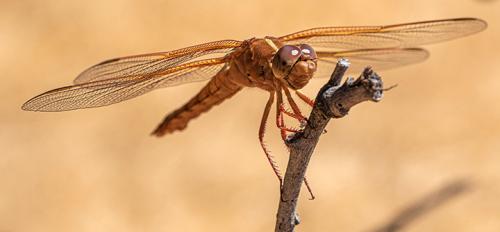
Tule and Cattail: A Tale of the Marsh Economy and Its Role in Human Health and Wellbeing
Workshop Set Sunday, March 17 in UC Davis Conference Center

A long-planned UC Davis symposium on “Tule and Cattail: A Tale of the Marsh Economy and Its Role in Human Health and Wellbeing” aims "to advance the land management aims of local tribal communities and provide a platform to educate about the importance of maintaining wetland biology for climate change, ecological and human health, and vector control,” announced medical entomologist-geneticist Geoffrey Attardo, associate professor, UC Davis Department of Entomology and Nematology.
The event, free and family friendly, will take place from 1 to 5 p.m., Sunday, March 17 in Ballroom B of the UC Davis Conference Center, located at 550 Alumni Lane. Registration is underway at https://qr.codes/xYbeAK or click on the QR code in the flyer below.
The symposium is sponsored by the UC Davis Department of Entomology and Nematology and the Pacific Southwest Center of Excellence in Vector-Borne Diseases, which aims to “strengthen the capacity to prevent and respond to emerging vector-borne diseases in the southwestern United States and Pacific Islands.”
Attardo has been working for a year on the collaborative outreach project to integrate indigenous ecological knowledge and Western science to provide educational outreach opportunities.
His collaborator is Diana Almendariz, a traditional ecological knowledge specialist and a cultural practitioner of Maidu/Wintun, Hupa/Yurok traditions, heritage, and experiences. She will discuss the precolonial relationships between native peoples and wetlands in Northern California, the impacts of colonization on those relationships, and the application of traditional ecological knowledge practices to restore damaged wetland ecosystems.

Attardo, who also chairs the Designated Emphasis in the Biology of Vector-Borne Diseases, will discuss how healthy wetland ecosystems contribute to addressing climate change, water management/retention, water purification, biodiversity, and mitigating vector-borne diseases. Following the presentations will be a hands-on session for those who wish to try their hand at weaving tule.
Noting that the islands in the wetland are populated with tule, a hardstem bulrush, Attardo said that "tules provide shelter to an array of wildlife. Red-winged blackbirds commonly build their nests in tule stalks. Reptiles and amphibians also live among them. Dragonflies frequently use tules stalks for eclosion and as perches. Fish also use the submerged stalks and root systems as nurseries. The tule acts as a water filter by sequestering excess nutrients from the water in collaboration with symbiotic microbes. The tule also stabilizes the banks and slows waterflow."

"The tule is also utilized by native peoples for a variety of purposes, including making sleeping mats, baskets, cordage, external and internal walls for homes, canoes," Attardo pointed out. "It also functioned as a food source."
Following the symposium, "we will follow this up with a multiweek limited attendance workshop on Sundays where we will perform a cultural burn on one of the islands in the wetlands at Cache Creek Conservancy,” Attardo said. “We will then reseed the island with tule and cattail using hand-woven tule mats embedded with cattail roots.”
Agenda (The symposium will start promptly at 1 p.m. so attendees are asked to arrive early).
Snacks and drinks will be provided.
1 to 2:30 p.m.: Presentation by Diana Almendariz: "Cultural History and Traditional Ecological Management of Wetlands" Exploring the deep connection between indigenous history and wetland ecosystems.
2:30 to 2:35 p.m.: Break
2:35 p.m. to 3:15 p.m.: Presentation by Geoff Attardo: "Wetland Biology and its Importance for Ecological and Human Health" Discussing wetland biology's significance in climate change, ecology, and vector-borne disease.
3:15 p.m. – 3:20 p.m.: Break
3:20 p.m.– 3:50 p.m.: Tule Weaving Demonstration: Participants will learn traditional Tule weaving techniques, connecting with the material culture of wetland management.
3:50 p.m. – 4 p.m. Break
4 p.m. - 5 p.m. Question and Answer Session: Attendees can engage with the speakers and delve deeper into the topics discussed.
(For more information, contact Geoffrey Attardo at gmattardo@ucdavis.edu)

